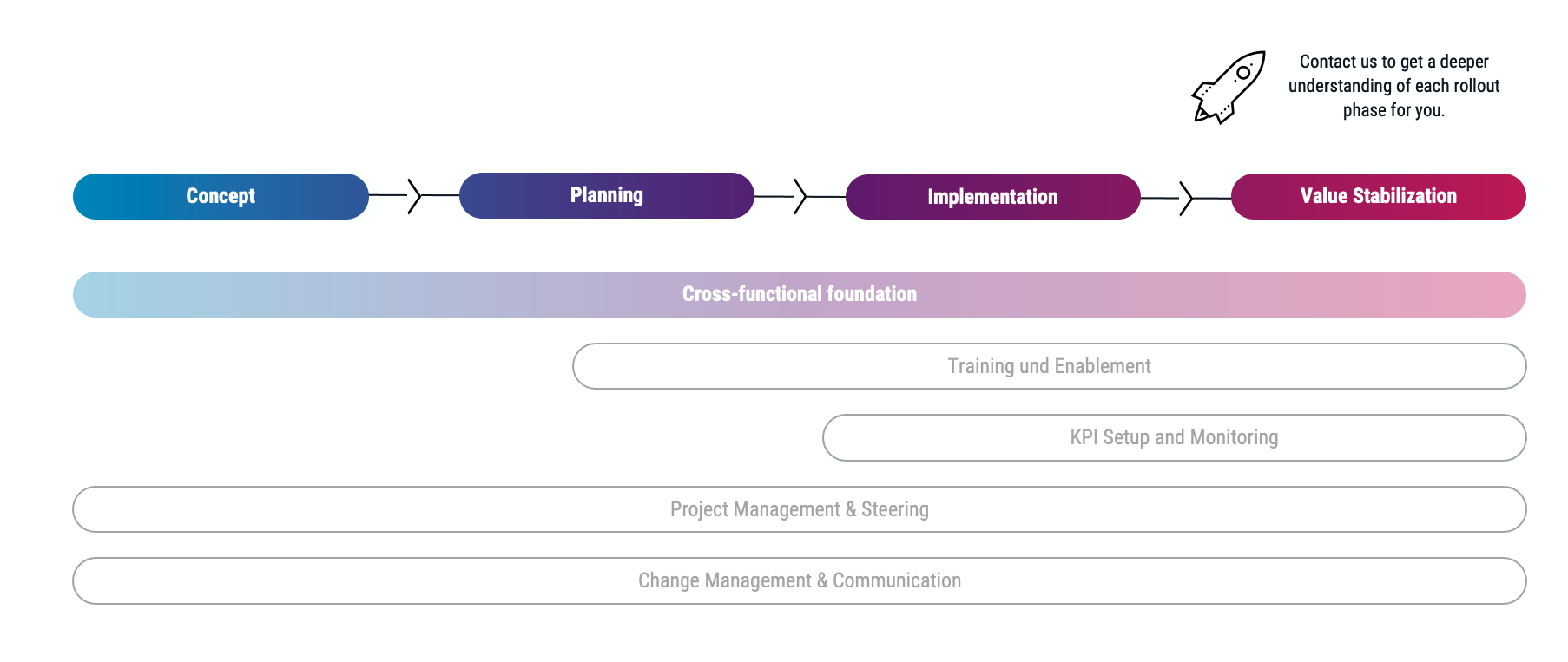Why are many rollouts doomed to fail?
Rolling out new systems, applications, and products is a challenging task that requires a lot of planning, collaboration, and commitment. While the purpose of the rollout is to improve operations and enhance customer experience, many organizations face challenges that prevent the success of the project.
Followed, we'll highlight some common rollout challenges organizations are facing (and how to overcome them.)
Scope Creep
The scope of a rollout project can change quickly and frequently. This is especially true when the project involves several stakeholders who may demand additional features or functionalities, or when new requirements emerge. Scope creep can cause delays, increase costs, and affect the quality of the final product.
(To avoid scope creep, it's essential to define and communicate the project's scope clearly, establish a change control process, and involve all stakeholders from the onset.)
Lack of Communication
Communication breakdown is a significant challenge in any rollout project. Failure to communicate effectively can lead to misunderstandings, missed deadlines, and lack of buy-in from key stakeholders.
(To overcome this challenge, ensure there is clear and frequent communication among team members and stakeholders. Provide regular updates on the project's progress, share relevant documentation, and encourage feedback.)
Resistance to Change
Change is not always easy, and some employees may resist new systems or applications. This resistance can manifest in various ways, including the retention to adopt new processes, lack of enthusiasm, or outright sabotage.
(To overcome this challenge, involve employees in the rollout process from the onset. Educate them on the benefits of the new system, provide training and support, and address any fears or concerns they may have.)
Rollout projects are not without challenges. However, by anticipating potential challenges, developing a solid plan, involving all stakeholders, and having contingency plans, you can overcome most challenges and ensure the success of your project.
At rpc, we understand the challenges involved in executing organizational changes and the importance of a seamless and implementation. With our expertise in Implementation, we help businesses navigate complexities and ensure successful execution of new processes, technologies, and strategies. From planning and stakeholder engagement to communication and risk mitigation, our team is here to optimize your implementation process sustainably. Experience a smooth transition and achieve transformative results.
The four steps
of your successful and sustainable rollout
Whether you're involved in technology implementations, product launches, or large-scale organizational changes, understanding the concept of rollout is essential for success.

A rollout can be structured into four main phases: Concept, Planning, Implementation, and Value stabilization.
In the Concept phase, the goals and requirements of the project are defined. This is where the foundation for the rollout is laid by establishing the vision and purpose.
The Planning phase involves detailed development of the rollout. In the Preparation sub-phase, all necessary resources such as personnel and technology are prepared. In the Sequencing sub-phase, the order of the individual steps is determined to create a clear roadmap.
The Implementation phase entails carrying out the rollout. Initially, there is the Pilot phase, where the rollout is tested on a limited scale to identify any issues and find solutions. This is followed by the Full Rollout, where the new systems or technologies are gradually extended to the entire target audience or organization.
The Value Stabilization phase aims to solidify the rollout. This includes providing training for employees, offering support, and monitoring usage to ensure successful integration.
The rpc approach encompasses the Cross functional activities & directives of Training & Enablement, KPI-Setup & Monitoring, Project Management, and Change Management & Communication to systematically lead any rollout to success:
- Training & Enablement: Providing the necessary knowledge and skills for a successful implementation.
- KPI-Setup & Monitoring: Defining goals and metrics and monitoring the progress and success of the rollout.
- Project Management: Structuring, planning, and monitoring the rollout to ensure a smooth process.
- Change Management & Communication: Preparing employees for changes and fostering a positive attitude through targeted measures and open communication.
These guidelines support the rollout by ensuring effective training, monitoring progress, successful project execution, and a smooth change process.
Let's have a look!
Which of these topics is the most interesting for you?
Store Concepts &
Retail Design
We ensure a transparent and inherently lean rollout process
IT Systems &
SOftware
We ensure a System rollout with a cutting-edge end-to-end approach
With rpc you get access to an internationally
experienced network of experts...
> 110
rollouts successfully implemented thanks to international rollout expertise with tailored frameworks
> 13.500
process steps recorded and reported
> 800
tools and best practices, to guarantee sustainable change
…and benefit from the combination of our know-how with our four pillars, which form the basic framework of the "rpc circle of excellence"


CONCEPT
The rollout scenario can be tested on a "small" scale as part of a pilot project. Important "lessons learned" can be derived from this, which play a key role in quality assurance for the entire rollout.
Concepts elaborated in the planning phase are thus continuously enriched and implemented with the appropriate tools. There is no such thing as a blueprint. Every rollout has different requirements that can be tested in the pilot phase.

PLANNING
Based on a defined scoping of the rollout, a project planning must be set up. This is fundamental and is continuously updated throughout the various rollout phases.
It is based on milestones, capacity requirements (central and local) and a clearly defined target picture.
In addition, a dedicated project team should be defined and given the corresponding responsibilities.

IMPLEMENTATION
During the implementation window, it is important to have a tracking tool available to monitor and control the process. Especially in this phase, regular exchange is essential, also to ensure an intact quality management.
Consequently, a (market)-specific - and a (market)-overarching steering office should be installed to avoid superfluous coordination rounds and to use valuable insights as a catalyst for efficient implementation.

VALUE STABILIZATION
A sustainable rollout success is not yet necessarily given with the successful implementation. Rather, this can only be assessed with certainty after a few weeks/months. Consistent questioning and a regular feedback process are used to transfer the rollout implementation into a continuous improvement process and ultimately to be able to achieve sustainable and not just short-term added value.










